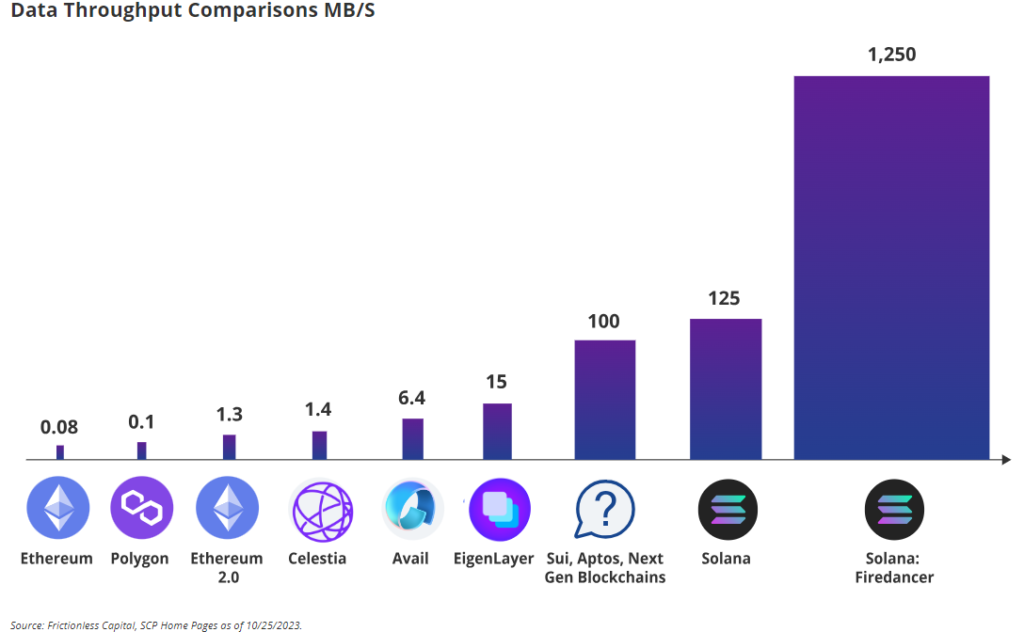A few months ago a report came out from VanEck about Solana.
First, lets start with VanEck. They are an american investment management firm.
They have around 76 billion assets under management, so they are not really a small firm.
To be honest, with all the noise about the bitcoin ETF, and how that was really the big, important news, it really surprised me to see that institutions are looking at something different than just Bitcoin.
Think about this for a moment.
The future is Blockchain
Reading the “Anthology of Balaji” i stumbled upon this quote.
“A framework I use often is the evolution from the physical version to the intermediate form, and then to the internet-native version. If you’re into electrical engineering, you can think of this as the evolution from analog to analog/digital, and then to native digital.”
You start to understand, the Blockchain will be the ultimate step of money. It will be the “internet-native version”.
It is space that is evolving very fast.
VanEck on Solana
VanEck issued this report where they highlighted very interesting points. The start of the report is literally this:
By 2030, our Solana valuation scenarios project a SOL price ranging from a bearish $9.81 to a bullish $3,211.28, anchored by varied market shares and revenue estimations across key sectors.
The first thing the caught my atention was that their price targets between bearish and bullish have the widest spread i have seen.
Try to compare that with a typical bear/bull target for a stock lets say Apple AAPL 0.00%↑ Bear of $24 and Bull of $4,596 , it would sound completely crazy right?
Now let me explain why i believe is the reason of this wide margin of price targets.
First is that they are not valuing an stablished company with clear products, revenues, and costs like Apple.
They are trying to model and forecast for a totally different kind of beast, which is Solana.
The wide spread between targets i believe is mainly due to the difficulty to accurately value it.
Basically its signaling “if its succesful we are going to the moon, if not we crash and burn”.
To be fair that is probably the most honest review they could do, lets face it, one of the main problems of crypto is the constant competitors on the space, new and better technologies are always flowing into the space.
For example Ethereum which is the second biggest cryptocurrency by market cap is seeing outflows to Solana.
People thought Ethereum would be the forever leader in things like “smart contracts”
At the rate of improvement and innovation we are seeing, there would be no such thing as a “leader” for long periods of time.
Solana value proposition
Lets begin with VanEck´s main points:
-
In this note, we model a scenario in which Solana is the first blockchain to host an application that onboards 100M+ users.
-
We assume SOL monetizes at only 20% of ETH’s take rate and achieves less than half of ETH’s market shares due to a fundamental difference in community philosophy.
-
We see a credible path to $8B in revenues for SOL token holders by 2030.
In the paper VanEck notes that main purpose of the SCPs (Smart Contract Platforms) is hosting apps so that users can engage in efficient and uncensorable ecnonomic activities.
They compare the low amount of users compared to other companies such as Facebook 2B + daily and Paypal 431 Million monthy.
They state: The reason why blockchain adoption hasn’t been faster already is because blockchains are clunky to use, and there is little to do on the chain besides exchange value and speculation.
Basically it needs a “Killer app”.
The chain that hosts that app will benefit immensely from the activity generated from that app.
They modeling a scenario where Solana is the first blockchain to host a single application that onboards 100 M + users.
Most important piece of the puzzle
Having said that they then go on to analyze what is the most important piece of the puzzle in order for a Blockchain to ncrease the probability of being able to host the next “Killer application”
Here is an exempt from the report that i found key:
The key question is measuring blockchain ability and understanding how that translates into useability. A popular metric, transactions per second (TPS), is an inadequate measurement that is easily manipulated.
In fact, the best metric to truly measure blockchain capacity is not transactions per second (TPS) but is instead data throughput.
Data throughput involves a blockchain ingesting, processing, and ordering data and then agreeing on that data’s impact on the blockchain’s ledger. Data throughput is determined by measuring the amount of data that can be received and applied by a blockchain over a given time period. The more data a blockchain can translate into ledger updates over a time increment, the better. As it stands, Solana’s data throughput exceeds that of any other blockchain in existence.

As of today, this is one of the most impressive things about Solana and probably the reason they have done some partnerships with Visa, Google, Paxos, etc.
It will definitely be an interesting path from here.
If you want to read the full report from VanEck, I will leave the link on the comment section.
Have a great day!
Zifush
